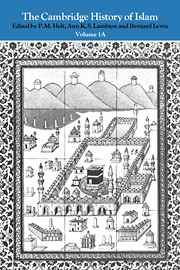Book contents
- Frontmatter
- Introduction
- Part I The rise and domination of the Arabs
- Part II The coming of the steppe peoples
- 1 The disintegration of the caliphate in the east
- 2 Egypt and Syria
- 3 Anatolia in the period of the Seljuks and the Beyliks
- 4 The emergence of the Ottomans
- Part III The central Islamic lands in the Ottoman period
- References
4 - The emergence of the Ottomans
from Part II - The coming of the steppe peoples
Published online by Cambridge University Press: 28 March 2008
- Frontmatter
- Introduction
- Part I The rise and domination of the Arabs
- Part II The coming of the steppe peoples
- 1 The disintegration of the caliphate in the east
- 2 Egypt and Syria
- 3 Anatolia in the period of the Seljuks and the Beyliks
- 4 The emergence of the Ottomans
- Part III The central Islamic lands in the Ottoman period
- References
Summary
In the second half of the seventh/thirteenth century, as the Seljuk state fell apart, a number of principalities (beyliks) of a new kind came into being in the western marches of Anatolia. They were in territory conquered as a result of holy wars (sing., ghazā) waged against Byzantium, and hence are known ghāzī states. The Ottoman principality was one of these. It was destined within a century to unite Anatolia and the Balkans under its sovereignty, and to develop into an Islamic empire. Let us now examine as a whole the formation of these ghāzī principalities. The emergence of the Ottoman state can be understood only in the context of the general history of the marches.
The emergence of Turcoman border principalities in western Anatolia
When the state of the Anatolian Seljuks developed into a fully formed Islamic sultanate, three areas came to be designated as marches par excellence, and attracted settlements of Muslim ghāzīs. In the south, facing Cilicia (Chukurova) the ‘realm of the Lord of the Coasts’ was centred round ‘Alā'iyya and Antalya and directed against Lesser Armenia and the kingdom of Cyprus. In the north, on the borders of the Byzantine empire of Trebizond and along the shores of the Black Sea, the Muslim marches consisted of two parts, the eastern, centred round Simere, Samsun and Bafra, and the western centred round Kastamonu and Sinop. Finally, the western marches, whose principal cities were Kastamonu, Karahisār-i Devle (Afyonkarahisar), Kütahya and Denizli lay along the Byzantine frontier from the area of Kastamonu to the gulf of Makri in the south.
- Type
- Chapter
- Information
- The Cambridge History of Islam , pp. 263 - 292Publisher: Cambridge University PressPrint publication year: 1977



